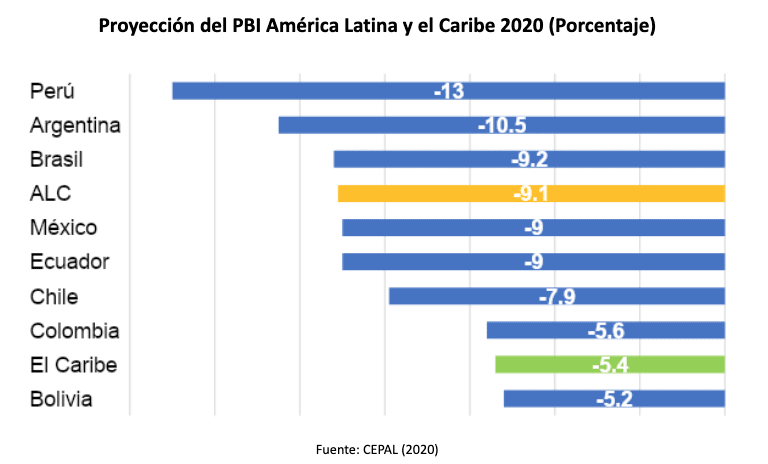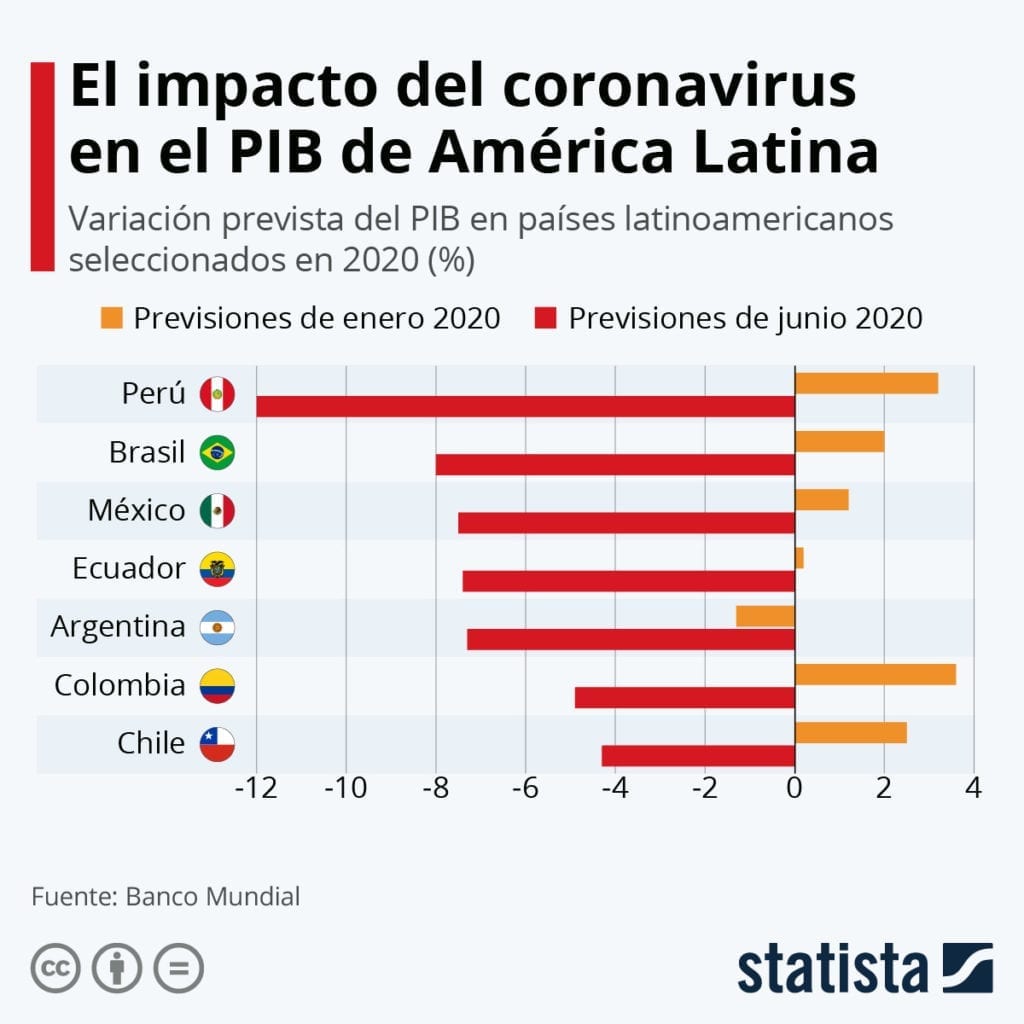Today, experts argue about the scale of the losses that the COVID-19 coronavirus pandemic that has already flared up around the world. In particular, last year was remembered by external shocks for the economy of the Latin America region, which already had low growth rates, and measures of social distance, various restrictions and company closings led to a structural crisis in the economic, social and industrial spheres. What are the forecasts for Latin American countries for 2021?
The year 2020 saw the largest contraction in the global economy since 1946 as a result of the impact of the coronavirus pandemic. As a result, Latin America and the Caribbean has become one of the worst affected regions in the world when we compare different indicators of health, economy, and social inequality. The emergence of an unexplored virus and the ensuing external shocks, the need for isolation, physical distancing and business closures have created a health emergency in a worst-case economic scenario.
While the decline in global economic activity has affected the region as a whole, and all countries have recorded contractions in their GDP, not all have been hit equally. Latin America already experienced low economic growth, averaging 0.3% between 2014 and 2019; and barely hit 0.1% in 2019, putting them on a difficult starting point at the time of COVID-19.
At the end of December last year, the Economic Commission for Latin America and the Caribbean (ECLAC), which coordinates policies to promote economic development in the region, published an annual report. According to experts, the GDP of Latin American countries in 2020 showed a record drop in 120 years. “The GDP of Latin America and the Caribbean is expected to fall by 7.7%, the largest decline since research began in 1900”, – the Commission declared in its report.

According to the ECLAC estimates, the most serious drop occurred: in Venezuela (-30%), in the Caribbean (from -15 to -18%), in Panama (-11%), in Peru (-12.9%), Argentina (- 10.5%), Ecuador and Mexico (-9%). The region’s largest economy, Brazil, shrank 5.3%. Venezuela tops the list of Latin American countries that fell the most at the end of the year by a wide margin. However, this figure is explained not only by the coronavirus pandemic, but also by other problems, due to which Venezuela experienced its seventh consecutive economic downturn in 2020.
Since 2014, the dynamics of the GDP of the oil sector of the Venezuelan economy has been characterized by a long and serious contraction. This situation has worsened in 2020 due to the consequences of the coronavirus outbreak, acute fuel shortages and tougher US sanctions against the government of Nicolás Maduro (Nicolás Maduro Moros). Although a division of the investment bank “Torino Capital LLC” (“Torino Economics”), based in New York, estimated that the fall in Venezuelan GDP in 2020 was less than the ECLAC calculated: 24.7%.
Analyzing the performance of countries in the report of the UN Regional Commission, it is worth noting that, unlike Venezuela, Peru entered 2020 with a history of a continuous decade of economic growth. Despite this, the South American state “closed” the year with a 12.9% drop in GDP, which, according to the ECLAC, makes it one of the hardest hit (countries) in the world from the coronavirus. “Torino Economics” noted in its report that in the midst of the pandemic, Peru implemented financial stimulus, one of the largest in Latin America, but its effectiveness was limited by strict containment measures and a sharp cessation of investment and exports, combined with falling prices for raw materials in international markets.
Argentina, like Venezuela, is one of the countries in the region that experienced an economic downturn even before the pandemic. The year 2020 was the third consecutive year of GDP contraction. The ECLAC estimates this drop at 10.5%, much higher than the 2.1% in 2019. “Torino Economics”, for its part, links the economic slowdown in Argentina to the crisis in sectors such as tourism, construction and transportation. In addition, it is pointed out that the impact of the pandemic has exacerbated the structural macroeconomic imbalances that Argentina suffers, especially in the financial, monetary and foreign exchange areas.
The Economic Commission for Latin America and the Caribbean (ECLAC) report emphasizes that the impact of the current crisis as a result of the pandemic has exacerbated the difficult economic situation in the region, which has already developed since the third quarter of 2019. The situation that developed in 2020 led to “a sharp drop in all components of aggregate demand”. With regard to oil exports from Latin American countries, from January to September 2020, this figure decreased by 44% year on year.
Looking into the future of 2021, the ECLAC officials believe that the economy of Latin America and the Caribbean will grow by an average of 3.7%, however, GDP growth will be guided by a recovery in domestic demand. Equalization of economic performance will primarily depend on the impact of various programs implemented by governments to respond to and combat the pandemic, as well as to support re-employment and mitigate social impact. The UN Regional Commission report notes that there are many uncertainties in this panorama, especially related to external conditions, such as the development of a pandemic during the year and a possible new drop in oil prices.

The ECLAC predicts the economic decline in 2021 only in Venezuela (by 7%), in other countries growth is expected – in Brazil by 3.2%, in Mexico by 3.8%, in Argentina by 4.9%. Analysts from the World Bank are in solidarity with the forecast of the Economic Commission for Latin America and the Caribbean, who presented on January 5 their view on the region’s prospects for 2021. The financial institution’s report also predicts a recovery in growth in the region by an average of 3.7%. In the largest countries, Brazil and Mexico, economic growth is expected to be 3% and 3.7% in the new year, respectively; and in Argentina and Colombia it will be 4.9%. Central America is forecast to grow 3.6% and the Caribbean – 4.5% due to a partial recovery in the tourism industry.
However, the World Bank does not rule out a negative growth forecast of 1.9% in case the SARS-Cov-2 coronavirus immunization process is delayed. This report summarizes the outcome of 2020, according to which the creditworthiness of Latin American countries has decreased, social inequality has increased, and poverty and internal political tension have increased.
In 2021, Latin American leaders intend to tackle economic recovery while trying to stave off the debt crisis and convince their citizens that democracy can still be effective. The change in overall economic indicators will depend on how Latin American countries could resolve their internal contradictions and develop a coherent and clear strategy to combat the coronavirus.


